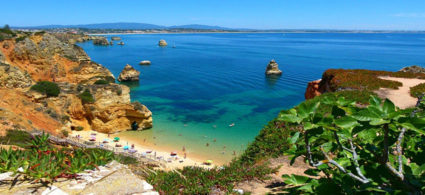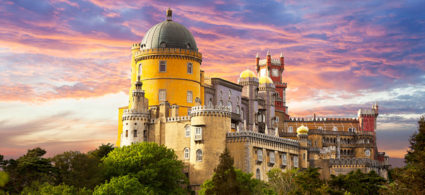

Portugal calls the attention of several tourists every year. From cities like Lisbon and Porto to the islands on the Atlantic Ocean, passing through the Algarve region and the Douro Valley; weather conditions are great all year long, especially in the south-western area.
It is a very popular destination, especially among Europeans, thanks to its cheap prices, the kindness of its people, its great food, its traditions, its beautiful beaches, and its landscapes.
The biggest cities of Portugal are located near the major rivers and are a delightful mix of history and contemporaneity. Lisbon is one of the most interesting capitals of Europe, while it is hard to beat the atmosphere and the magnificent scenario of Porto.
On the other hand, Coimbra is famous for its ancient university, Obidos, Marvao and Monsaraz are beautiful and very well preserved medieval towns. Evora is one of the most ancient towns; it is still possible to admire its medieval walls and palaces from the XIV century.
Visit Aveiro and its canals; Aveiro indeed is called the Venice of Portugal. Every street is characterized by beautiful examples of Portuguese architecture.
The cities of the Algarve coast reflect the traces of the Moorish invasion in Portugal. Above all there is Tavira, with its traditional white houses, big arches, and bridges connecting to the center.

Lisbon stretches over seven hills overlooking the estuary of the Tagus river; the historical districts of Castelo, Alfama, Mouraria, Bairro Alto, Madragoa, Chiado and Belém share the charming history of the city.
Bairro Alto is one of the most charming districts of Lisbon, and it is famous for its lively nightlife. Chiado has always been a meeting point for intellectuals and artists, and today it has become one of the most elegant and wealthy areas of Lisbon.
The district of Alfama, just below the castle, is the oldest are of the city. It has been inhabited for centuries, and today it is known as the romantic heart of the city. From here you can take a walk to the São Jorge Castle, enjoying the stunning views of the city. Baixa is famous for being the shopping district of Lisbon.
Do not miss a walk along Avenida da Liberdade, a boulevard featuring historical and elegant buildings. Enjoy the best Portuguese cuisine at one of the several restaurants in the center. Explore Parque des Naçoes, the district that hosted Expo in 1998. Walk all the way to Belem to admire the Belem tower, the Jeronimos Monastery, and the Monument of the Discoveries.
Find more about Lisbon

Perched on top of the hills, on the sides of the cliffs, Porto is crossed by the Douro river. Proud of their heritage, the citizens of this mercantile cities have invested all their efforts in trading their famous wine.
The traditions of the Northern capital of Portugal are very different from the ones of Lisbon; here clubs and restaurants alternate to cathedrals, churches and museums overlooking narrow streets and large boulevards. Porto can be easily visited on foot, as long as you don’t mind the ups and downs of its streets.
In the last decades there has been a revitalization of the city, with a restyling and modernization of buildings, streets, and squares. Porto combines the charm of the old with the new: from the contemporary Casa da Música to the old Sé Cathedral. Time just flows through the streets of Porto.
As you cross the river you will find the city of Vila Nova de Gaia, which is home to the famous Porto wine cellars. With its distinctive character and a rich atmosphere Porto will conquer you straight away.
Find more about Porto

Coimbra, a university city of great culture and beauty, once was the capital of the kingdom of Portugal. It still has many historical palaces and buildings from its glorious past, such as the ancient Royal Palace.
Coimbra is crossed by the Mondego river, therefor do not miss a relaxing walk along its shore. While strolling around the city you will be very likely to meet students wearing the typical university uniform, which includes showy black hats.
Coimbra keeps all the traditions of Portugal, from the cuisine to the music. This is the city where some peculiarly shaped fado instruments are made. Do not miss the sunset on the Clock Tower, which marks the passing of every hour.
Find more about Coimbra
In Portugal there are some of the most beautiful villages of Europe. The mix of heritage, culture, and charm attracts visitors from all over the world. Although they don’t offer the same attractions of the other big cities, these villages are still very interesting.
It is impossible to find these places boring: the weather, the food, the sea, the history, and the people will steal your heart!
They are often located at the top of a mountain, and they can be seen thanks to their tall towers and medieval castles. Moorish, christians, Spanish, and Portuguese have tried to conquer these villages during the passing of centuries.
This conquering interest have left some unique historical traces in these villages. Today they offer a quiet atmosphere where the authenticity of Portugal is preserved thanks to their inhabitants who are closely connected to their traditions.
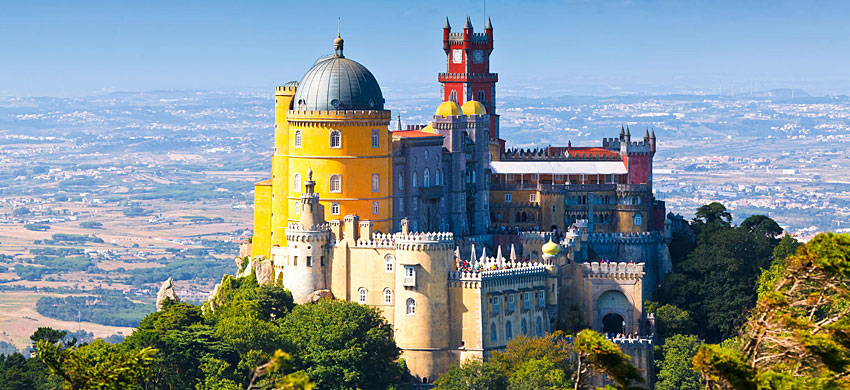
Situated about 30 km north-west from Lisbon, Sintra is the most romantic place of Portugal. It is a UNESCO world heritage site and it was built at the foot of the ruins of a moorish castle. Its fairy castles and its ancestral houses overlook a lush vegetation, giving a touch of sacrality to this place, which stays aside from the chaotic city noises of Lisbon or from the cosmopolite cities of Cascais and Estoril.
The mystical and romantic charm of Sintra has inspired its architecture, which today represents one of the main attractions of this town: the Palacio Nacional de Sintra, with its cone-shaped chimneys, is a charming blend of architectural styles. It has the greatest collection of Mudéjar tiles in the country.
The Pena Palace is characterized by its domes, towers, and polished bridges, which are typical from the Bavarese style. Do not miss a visit to Quinta da Regaleira, surrounded by a garden, caves, a well of initiation and mythological symbols.
Lastly, visit the eastern-style palace and the exotic gardens of Monserrate, with more than 3.000 species of plants.
The village of Sintra is a charming labyrinth of narrow and steep streets, small shops, and traditional restaurants. Speaking of food, do not forget to taste the famous “queijadas” (cheese pastries), and the “travesseiros” (pastries with eggs and almonds).
Find more about Sintra
Obidos is considered one of the most romantic villages of Europe thanks to its colorful houses with bouganville, gothic landscapes, pebble streets, and churches with a white facade surrounding the castle from the XII century.
If you are on a romantic gateway, do not miss the opportunity to stay at one of the many rooms of the castle. To discover the beauty of Obidos, walk around the center, try to spot the hidden and secret corners overlooking a breathtaking view.
If you are planning to visit the village in July, do not forget to attend the medieval fair: music, knights, and theatrical performances will take you back to 1500. If you love liquors, taste the Ginja de Obidos, a cherry liquor produced in this region.
Lastly, do not miss the main Obidos gate, admire the chapel decorated with blue and white azulejos representing the passion of Christ.
Find more about Obidos
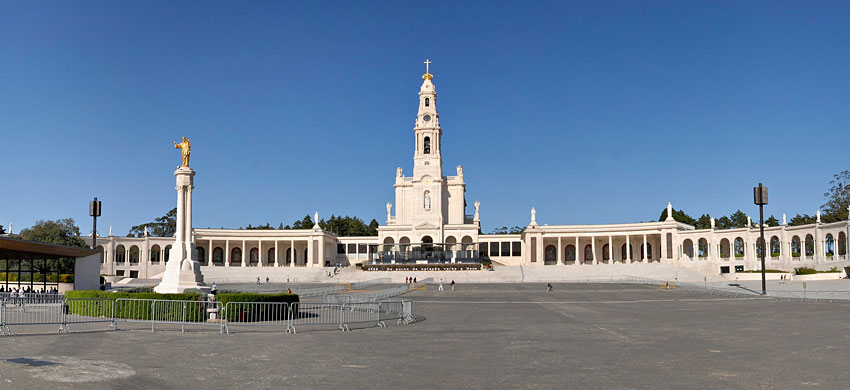
Fatima is one of the most important catholic pilgrimage sites in the world. It became famous thanks to a series of witnesses of mystical visions of the Holy Mary. Whether you believe it or not, Fatima is by far a charming place that deserves a visit.
The importance of this sanctuary reflects the number of people who visit it: more than 4 millions of pilgrims every year. There are testimonies of miraculous healing after visiting these places and these stories show that this place does not attract only religious people, but whoever is interest in historical and cultural sites.
It is easy to reach Fatima thanks to its central position and its great connecting services. Fatima also provides a high standard of services.
Along the pilgrimage towards the Sanctuary there are many places where to stop by, corresponding to the places where the mystical views have been witnessed. Near Fatima do not miss a visit to the suggestive late gothic monastery of Batalha and to the monastery of Tomar.
Find more about Fatima
The Alcobaca Monastery, UNESCO World Heritage site since 1989, is one of the best examples of Cistercian architecture in Europe. Although it was built about 900 years ago, it still preserves its medieval buildings. The church is the biggest primitive gothic church built in Portugal during the Middle Age.
The monastery was built during the foundation of Portugal as a country, and it shares a part of its history. The Cistercian Order was founded by the first king of Portugal, D. Afondo Henriques, after the donation of lands to commemorate his victory over the Moors during the conquer of Santarém.
The construction began in 1178, following the model of the abbey of Claraval, the mother church of the Order in France. On the facade of the monastery, only the gothic gate dates back to the original project: the statues of São Bento and São Bernardo, located on the sides, make a contrast with the baroque frontispiece and the bell towers which were added in the XVIII century.
Once inside the monastery, the great central nave, stripped of any ornament, produces a feeling of elevation and spirituality. At the center of every transept there are two masterpieces: the tomb of D. Pedro I (1357-67) and D. Inês, which are positioned one in front of the other in order to meet again during the Day of Resurrection.
With more than 800 km of coast, Portugal has plenty of beaches: about half of the Portuguese border is made of the Atlantic coast and here there are villages of all kinds.
Along the coast there are some destinations that you should miss, which have called the attention of thousand of tourists during the passing of the years. In particular, the southern region of the Algarve represents the ideal destination for a beach holiday with modern services, a breathtaking landscape and an atmosphere that managed to find the right balance between modernity and tradition.
But there are many other beach destinations; from South to North there are many villages that perfectly represent the traditional Portuguese culture. These are often fishermen villages where the lives of ordinary people still revolve around fishing. Wherever you go, will will be embraced by a warm and welcoming spirit.
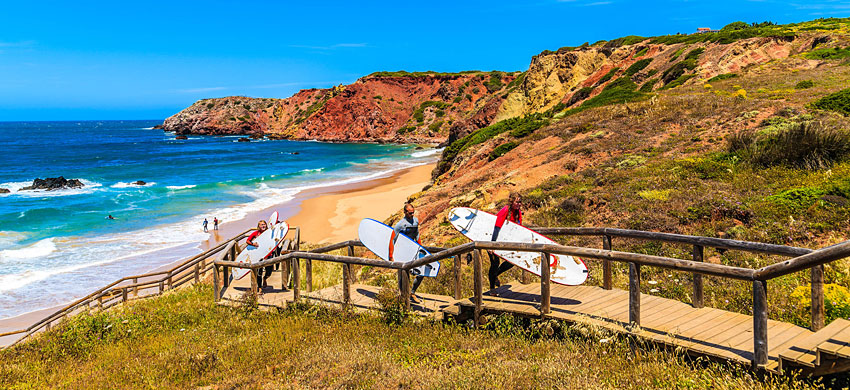
It was precisely from the Algarve, in the fifteenth century, that the Portuguese started their epic journeys towards the discovery of the new world. And it is precisely in this land of adventure that travelers will feel greeted in warm hugs.
The region, famous for its beach towns, has a great advantage: it has a moderate and sunny weather all year long. Besides the typical and traditional villages, which have now become more modern, the region features some high-quality beaches. There are both dandy and rocky beaches.
In some places the waters are calm and suitable for families with babies, while in other places the beaches are windy, and perfect for those who practice water sports.
The landscape of the inland of the Algarve offers some hilly landscapes and traditional villages. Here life is more simple and you can’t really feel the impact of mass tourism. Visit Silves, which keeps traces of its Arab past, and Lagos which still carries that same atmosphere of when it was discovered.
Portimão and Albufeira are more cosmopolite, offering all kind of entertainments both during the day and during the night. Tavira is the greatest example of its traditional architecture, a mix of moorish and European influences. Faro, the administrative center of the region, deserves a long stop to discover its beautiful old town.
Those who are looking for some relax can treat themselves to one of the many wellness centers of thalassotherapy in Monchique.
Golf is frequently practiced in the whole region, and there are many internationally known golf courses. If you love this sport, do not miss the chance to spend an afternoon playing it.
Find more about the Algarve
Figueira da Foz is located on the estuary of the Mondego River and it represents one of the main seaside places of Central Portugal. It is a lively and cosmopolite city and its popularity started towards the end of 1800, when the aristocrats of Portugal used to spend their holidays in Figueira.
Figueira da Foz offers a wide choice of accommodations, a casino founded in 1900, and an excellent beach with the longest stretch of sand of the whole country, offering ideal conditions for all kinds of water sports. Sail and motorboat competitions are often held here.
In the surrounding area it is worth a hike to the Serra da Boa Viagem to appreciate the panoramic view of the Miradouro da Vela. During the clearest days it is also possible to see the Berlengas islands.

A well known village of Portuguese fishermen, Nazaré has always attracted visitors thanks to its beautiful beach and lively life. You will be charmed by the traditional costumes worn by local people; shirts and trousers for men, while women wear different layers of perfectly ironed slips.
Stroll around the harbor where you will see hundreds of fishing boats, many of which follow the town’s extravagant style and whose sails are decorated with bright colorful phoenix drawings.
This place is perfect for those who love practicing surf and other water sports. Give your back to the see and try to spot the top of the Sitio mountain, which offers one of the most famous views of the Portuguese coast. It is a 300-meter-high mountain that can be reached on foot or by taking a cable car.
At the top of the mountain there is the chapel of Ermida da Memória, famous for the legend of the miracle of the Holy Mary who made the horse of D. Fuas Roupinho turn away and saved his life. Sítio is also home to the Sanctuary of the Nazarene.
Find more about Nazaré
Portugal is a country with some spectacular landscapes, magnificent beaches, and a rich cultural heritage; visiting it is also an opportunity to discover some of the world’s best spots where to surf. Besides the mainland, its islands have so much to offer.
The Portuguese islands are a real natural paradise, calling the attention of tourists coming all over Europe. Among these islands, there are the ones off the Algarve coast, including Ilha de Armona and Ilha da Tavira. However, the volcanic archipelagos of Azzorre and Madeira deserve their own paragraph.

The Azores are a volcanic archipelago of 9 islands. Nature lovers will find uncontaminated landscapes: each island is different from the other and has their own natural features.
For instance, the island of Flores is mountainous and lush, while the island of Sao Miguel is a stretched plain. Due to the volcanic origins of the islands, it is possible to witness some volcanism, including hot springs, such as the ones of Furnas di Sao Miguel.
On the Azzorre there are several traditional villages such as Angra on the island of Terceira or Horta on the island of Faial.
The diversity of these islands is also about their mix of culture and tradition. The strategic position of the Azzorre, which are located between Europe and the Americas, turned it into a special place for migrant people.
The Azzorre island have been secluded also by the Portuguese continent, both for social and political reasons. The habits and practices of the inhabitants are different from the ones of continental Portugal.
Try the hospitality of the Azzorre, the flavors of its cuisine, the desert areas interrupted by valleys, cliffs, villages and sea. The Azzorre are the perfect destination for snorkeling lovers; its waters are populated by many kind of fishes and mammals. Daily boat trips are organized for whale and dolphins watching, as well as snorkeling and diving activities.
Find more about the arcipelago of the Azores

Far from the South-West coast of Portugal, right in the middle of the Atlantic Ocean, there is the Madeira archipelago, which is made of 3 islands: Porto Santo, Desertas, and Madeira.
The island of Madeira rises from the sea with rocky peaks and cliffs as well as valleys. It has a sunny and pleasant weather all year long, making its soil particularly fertile.
It is a very popular destination among the British who love spending the warm winter on the island. However, today Madeira is expanding its horizons turning into a popular destination for those who wish to enjoy a beach holiday, go hiking and stay in touch with nature.
Funchal is the capital of the island, providing all the main and most efficient services. Choose to visit Madeira if you like water sports, diving, trekking, paragliding and much more!
Find more about Madeira and Porto Santo
In Portugal there are several well preserved nature reserve. In these environments, scattered all over the country, nature and mankind live in perfect harmony.
These protected areas aim at preserving their biodiversity and therefore are classified as Natural Parks and Reserves, where it is possible to go on excursions and do some trekking.
These parks are very well organised, featuring suitable paths also for families traveling with kids or for people with minor disabilities. They represent a good alternative to avoid the noises of cities like Lisbon and Porto. Some parks indeed are located not too far from the center of these cities.
In the following map you can see the location of the main places of interest mentioned in this article.



